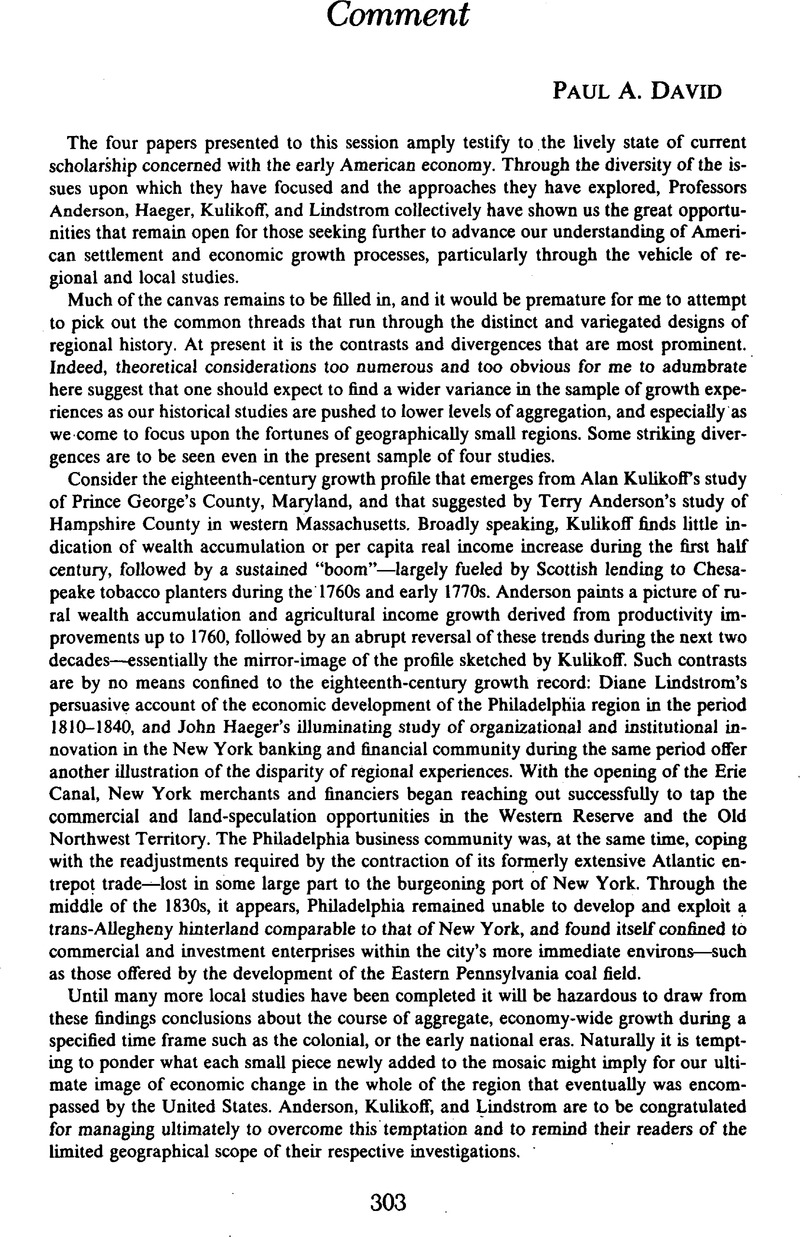Article contents
Abstract

- Type
- Papers Presented at the Thirty-Eighth Annual Meeting of the Economic History Association
- Information
- Copyright
- Copyright © The Economic History Association 1979
References
1 Jones, Alice H., “Wealth Estimates for the American Middle Colonies, 1774,” Economic Development and Cultural Change, 18 (07 1970)Google Scholar; and American Colonial Wealth: Documents and vols. (New York, 1977)Google Scholar.
2 Main, Gloria L., “Personal Wealth in Colonial America: Explorations on the Use of Probate Records from Maryland and Massachusetts, 1650-1720,” unpublished Ph.D. dissertation, Columbia University, 1970Google Scholar; and “The Correction of Biases in Colonial American Probate Records,” Historical Methods Newsletter, 8 (03 1974), 10–28Google Scholar.
3 Cf. the extensive discussion of these matters in Anderson, Terry L., The Economic Growth of Seventeenth Century New England, (New York, 1975), 97ffGoogle Scholar. , and the reference made by Kulikoff in his footnote 6.
4 An additional problem is introduced by Kulikoffs acceptance of unit land values, undeflated for changes in the general price of uncultivated land, in estimating average wealth holding. The movable property component of probated wealth has been'expressed in some form of constant prices. There is thus some reason to believe that the rise in “average wealth,” and the shift in the importance of landholding therein, which appears from Kulikoffs estimates (Tables 1, 4) for the period 1755-1776, is in some significant part a revaluation phenomenon connected with the impact of capital inflows upon the market for already improved land-not purely a reflection of real capital formation activities.
5 Ball, Duane E. and Walton, Gary M., “Agricultural Productivity Change in Eighteenth-Century Pennsylvania,” this Journal, 36 (03 1976)Google Scholar. A subsidiary technical problem with Anderson's classification scheme is that livestock appearing in the estate inventories are treated as output, but do not correspondingly figure among the inputs. It would be more appropriate to treat the stock of animals as a form of reproducible capital input, that generated a flow of animal products. Close examination of Anderson's estimates, (Tables 1,3) however, reveals that the main movements of the output and productivity indexes are dominated by the crop-output estimates, rather than the livestock component.
6 The distinction between the estate of a farmer and the fanning unit gives rise to another worrisome question: it is not clear that the observations obtained by Anderson refer uniformly to integral units of agricultural production controlled by the population of decedent farmers. The deceased farmer may have owned land leased to other (younger?) farmers. Such land, and the buildings too, would appear in the estate inventory, but the crops and livestock of the tenants would not. Equally, the inventory may contain livestock and crops produced on land leased from others. Productivity calculations made on the (unjustified) assumption that all outputs and inputs were owned in equal degree could prove seriously misleading if the degree of farm ownership was systematically related to the age of the farmer, or if it underwent secular changes.
7 I have followed Lindstrom in ignoring effects of relative price changes, mainly for the sake of ex-positional clarity. But the neglected effects must in any case be small. Retail prices of purchased foods rose 4 percent relative to the Brady-David-Solar consumer price index between 1809 and 1839. (Cf. Paul A. David and Peter , Solar, “A Bicentenary Contribution to the History of the Cost of Living in America,” Research in Economic History, 2 (1977), 1–80Google Scholar, Table A.5.) Constraining the price and income elasticities in the (Slutsky) demand equation for agricultural products to sum to zero, and assuming the cross-price effects sum to a small positive magnitude (say, 0.1), then the maximum value oft; considered by Lindstrom (0.7) implies that the own-price elasticity of demand would not exceed 0.8. Hence neglected relative price effects exert a drag on per capita consumption growth amounting at most to 3.2 percentage points spread over a 30-year interval.
8 When examining the alternativefiguresentered in col. S of the table, it should be recalled that the estimated share of agricultural output in total regional gross product in 1840, according to Lindstrom, is: YAC/Y + YAE/Y = 0.500 + 0.026 = 0.526. From columns 4 and 5 of Table 1 it is seen that the share of agricultural consumption (YAC/Y) in 1840 is uniformly below the estimated share(s) for 1810, for all (η, x) in which 0 < η < 1 and 0 < x.
- 2
- Cited by


